MONOPSONY - WAGE DETERMINATION IN IMPERFECTLY COMPETITIVE LABOUR MARKETS
1/65
There's no tags or description
Looks like no tags are added yet.
Name | Mastery | Learn | Test | Matching | Spaced |
|---|
No study sessions yet.
66 Terms
What do imperfections result from?
Imperfections frequently result from elements like monopolistic power, TUs, and incomplete information.
Market inefficiencies can result from these flaws, which can have a major impact on pay rates and employment levels.
When does a monopsony occur?
market condition known as monopsony occurs when there is just 1 customer - or in case of lab. mkt - employer.
In these situations, employer has considerable market power & is able to set wage rates & employment levels.
What can monopsonistic employers do?
Monopsonistic employers can lower both the relative pay rate and the amount of employment below levels that would be present in a labour market with perfect competition by using their market dominance.
How is monopsony seen in labour markets?
An example of monopsony occurs when there is 1 maj. employer & many workers seeking to gain employment.
If there is only 1 main employer of labour, then they have market power in setting wages & choosing how many workers to employ.
What are examples of monopsony in labour markets?
Coal mine owner in town where coal mining is the primary source of employment.
The government in the employment of civil servants, nurses, police and army officers.
Draw diagram of a monopsony.
In a competitive labour market, the equilibrium will be where D=S at Q1, W1.
However, a monopsony can pay lower wages (W2) and employ fewer workers (Q2)
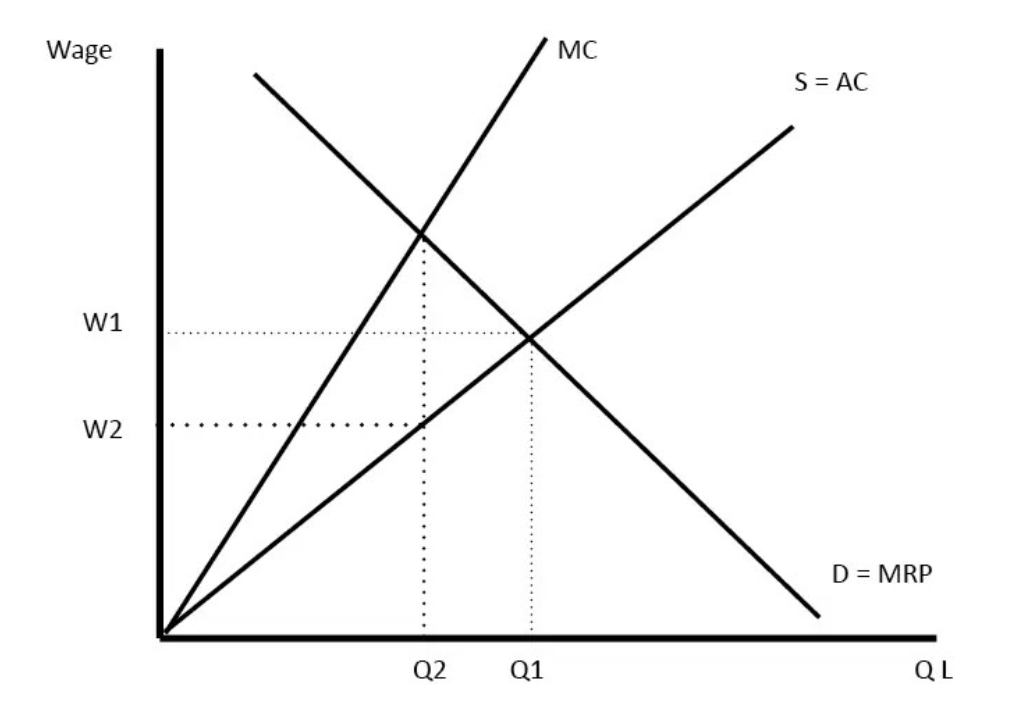
Where is profit max. for a monopsony?
Marginal cost of employing 1 more worker will be higher than AC – because to employ 1 extra worker the firm has to increase the wages of all workers.
To max. level of profit, firm employs Q2 of workers where MC of labour equals MRP. MRP = D
In a competitive labour market, the firm would be a wage taker. If they tried to pay only W2, workers would go to other firms willing to pay a higher wage.
What can minimum wage do in a monopsony?
In a monopsony, a minimum wage can increase wages without causing unemployment.
Draw a diagram of minimum wage in a monopsony?
A monopsony pays a wage of W2 and employs Q2.
If a minimum wage was placed equal to W1, it would increase employment to Q1.
A minimum wage of W3 would keep employment at Q2.
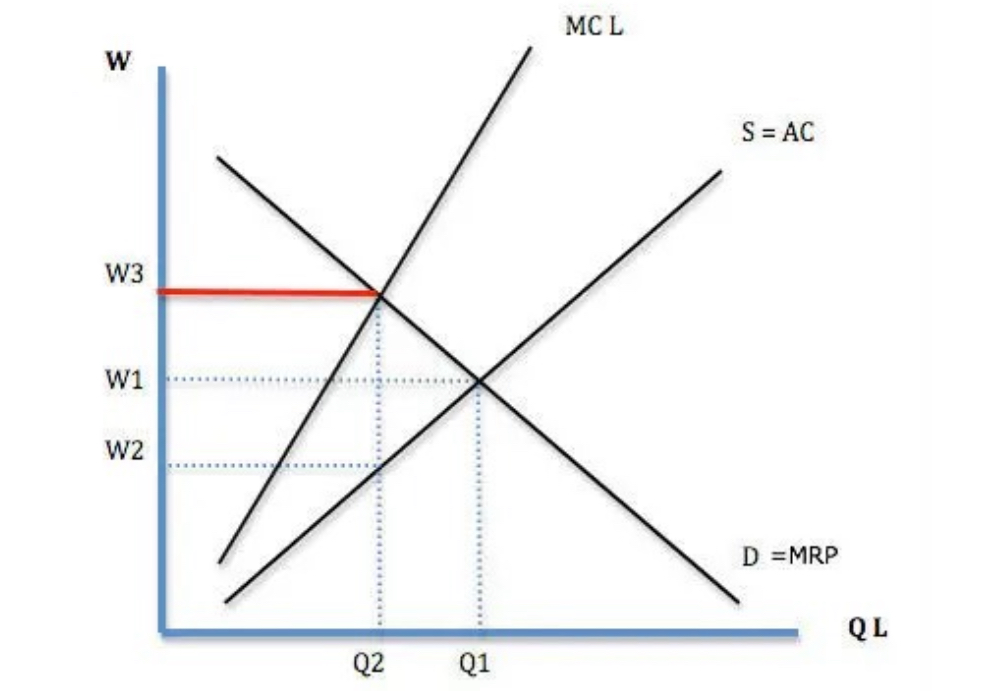
What happens if there is more than one employer?
Even if there is more than one employer, firms may still have the ability to set wages and have a degree of monopsony power.
For workers, there are significant costs and difficulties in moving between employers.
This means that if wages are low, it is costly to give up the job and work for a firm with slightly higher wages.
How can firm have degree of monopsony power?
Even if a firm is not a pure monopsony, it may have a degree of monopsony power, due to geographical and occupational immobilities, which make it difficult for workers to switch jobs and find alternative employment.
How can monopsony be seen with supermarkets?
E.g. there are several employers who might employ supermarket checkout workers.
However, in practice, it is difficult for workers to switch jobs to take advantage of slightly higher wages in other supermarkets.
There is a lack of info. and barriers to moving jobs.
Therefore, although there are several buyers of labour, in practice the big supermarkets have a degree of monopsony power in employing workers.
What is the gig economy?
The gig economy refers to recent trends towards self-employment and very flexible labour practises.
How can monopsony be seen in the gig economy?
In practice, workers in the gig economy can easily face a monopsony employer.
E.g. Uber drivers have little control over rates of pay and have to meet strict criteria from Uber.
In theory, they could work elsewhere but in practise it is difficult to replicate that job.
What are problems of monopsony in the labour market?
Monopsony can lead to lower wages for workers. This increases inequality in society.
Workers are paid less than their MRP.
Firms with monopsony power often have a degree of monopoly selling power. This enables them to make high profits at the expense of consumers and workers.
Firms with monopsony power may also care less about working conditions because workers don’t have many alternatives to the main firm.
How can monopolist be seen in product markets?
In several industries, there is 1 buyer and several sellers.
Supermarkets have monopsony power in buying food from farmers. If farmers don’t sell to big supermarkets, there are few alternatives. has led to farmer protests about the price of milk.
Amazon is 1 of biggest purchases of books. If publishers don’t sell to Amazon at a discounted price, they will miss out on selling to the biggest distributor of books.
What are workers represented by?
Workers' collective negotiating power is represented by trade unions.
They bargain with employers to obtain better pay, benefits, and working conditions for their members.
What can strong trade unions do?
Strong TUs can result in higher wages and better worker protections, but they can also cause labour market rigidities and cause u/e when compared to competitive labour markets.
How can TUs bargain for wages?
Under certain conditions, TUs can bargain for wages above the competitive equilibrium
This can be achieved by restricting the supply of labour (e.g. closed shops) or threatening to go on strike.
Draw diagram of trade union impact.
Trades Unions can cause higher wages, however, in competitive markets, this can have the effect of causing unemployment of Q1 – Q2
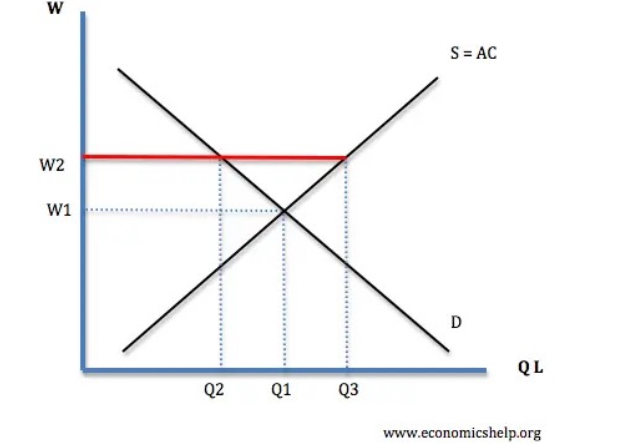
When can trade unions be beneficial?
If:
They operate in industry with Monopsonistic employer
They help to increased productivity by bringing in new working practices
Demand for labour is inelastic
Efficiency wage theories – when higher wages lead to higher productivity.
How does imperfect info. lead to imperfections in lab. market?
Asymmetry of information between employers and employees can skew wage determination.
Employers may take advantage of workers' inadequate awareness of industry standards for pay or job requirements to provide cheaper compensation.
How does poor info. lead to monopsony power?
Workers or firms may suffer from poor information.
E.g. workers may be unaware of better-paid jobs elsewhere.
Poor information is one factor that enables firms to have monopsony power.
How does disinclination lead to imperfections in lab. mkt?
Firms may not be rational but pay some workers different wages on the grounds of age, race, or gender.
How does difficulty to measure productivity lead to imperfections in lab. mkt?
Theory of MRP assumes firms can measure MPP of worker.
However in practice this is difficult as in many jobs, especially in service sector productivity cannot be measured precisely e.g. how do we measure productivity of nurses and teachers?
Therefore wages may be set due to diff. reasons other than MRP
How does whether firms are profit maximisers cause imperfections in lab. market?
Firms may be non-profit maximisers
If D for product falls, MRP theory suggests wages are likely to fall.
However, firms may be reluctant to cut wages or make people redundant thus they may keep paying high wages despite this.
How does geography cause imperfections in the labour market?
Wages will vary due to geographical differences
Draw diagram showing geography causing wage disparities.
In north (e.g. Sunderland), wages tend to be lower because there are less D, higher u/e and more elastic supply curve of labour.
In South, wages tend to be higher for opposite reason – firms are more profitable & are willing to pay higher wages.
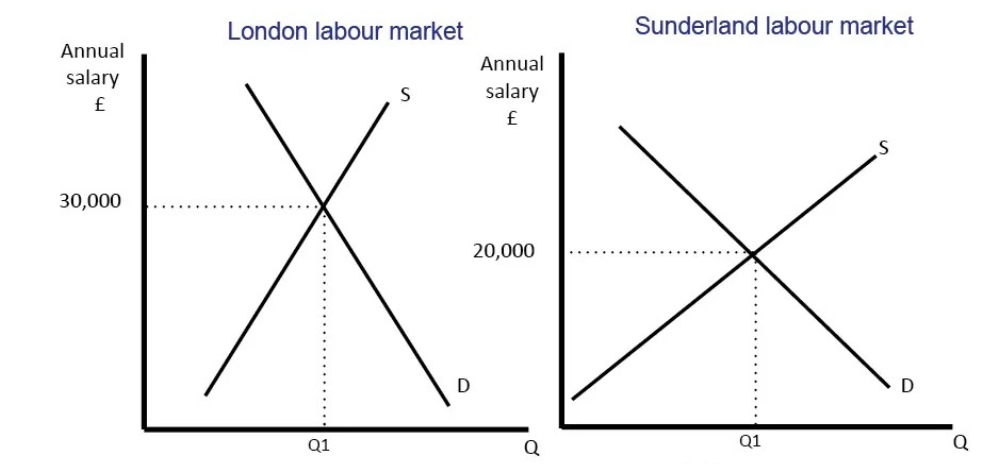
Why don’t workers from north move to south?
In theory, workers from north could move to south to take advantage of better employment opportunities.
However, there are likely to be geographical immobilities – e.g. it is difficult for workers to move.
What are examples of geographical immobilities?
Workers have attachments to their local communities – friends, children at local schools.
Difficult to find housing in the south.
Poor information about jobs elsewhere
How do occupational immobilities lead to imperfections in the lab. market?
Even at periods of full employment (strong econ growth) workers can be u/e due to occupational immobilities.
This involves having inadequate skills for lab. market.
In fast-changing econ, some workers can be left behind when old industries close down & their former skills are not transferable to new jobs.
E.g. manual workers from manufacturing may struggle in a high tech service sector based economy.
Ca lead to structural unemployment.
What does employer have power over in monopsonistic labour market?
The employer has a significant amount of power over the wage-setting process in a monopsonistic labour market.
How can monopoly employer put downward pressure on wages?
By hiring fewer people at a lower wage, they can put downward pressure on wages.
In contrast to mkt with PC, results in lower relative pay rate.
As there are fewer employment possibilities, monopsonistic businesses may force workers to accept lesser pay as there aren't many other options available.
Draw diagram showing monopsony employers.
PC market results in competitive wage & lab. employed of Qc - at the level where market S = market D
Monopsony employer sets wage at profit max. level MRP = MC
looking at diagram, quantity of lab. employed by monopsony employer is Qm & respective wage rate is lower than comp. wage
as matter of fact, monopsony employer can afford to pay higher wage, but as profit max. firm they underpay workers so they can make more profit
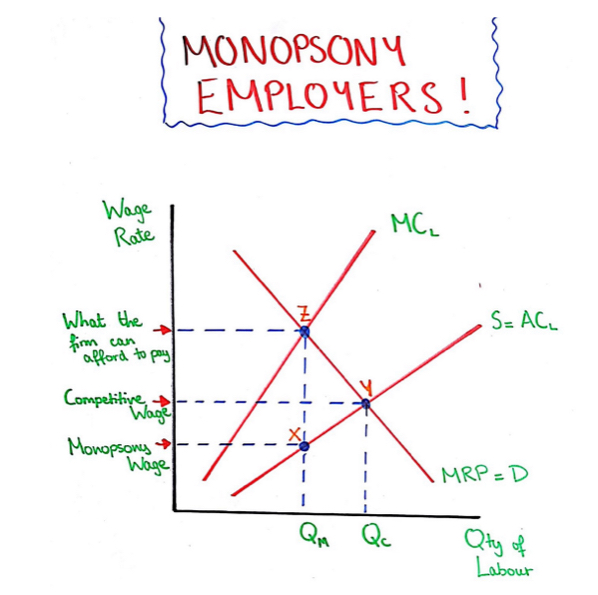
What does monopsony power enable firms to exploit?
Arguably, monopsony power enables firms to ‘exploit’ workers by setting lower wages and employing fewer workers than in a competitive market.
How can coal show monopsony?
To visualise monopsony power, could think of coal mining town in 19th C.
In these towns, principal source of employment was coal mine owner (or cotton mill owner).
If workers couldn’t get employment in coal mine, or cotton mill, were few other alternatives.
Hence we can understand why workers in Victorian era were often facing low wages and dreadful conditions.
In this case of monopsony power, coal mine owner has ability to be wage setter. monopsony can pay wages lower than in comp. mkt.
Draw diagram showing monopsony exploitation.
MC of employing extra workers increases at faster rate than AC. Because if you increase wage rate to attract more workers, you have to pay everyone a higher wage.
Monopsony maxs profits by employing Q of workers where MR = MC (Q2). means they only have to pay wage of W2. is lower than wage in comp. market (W1), there are also fewer workers employed.
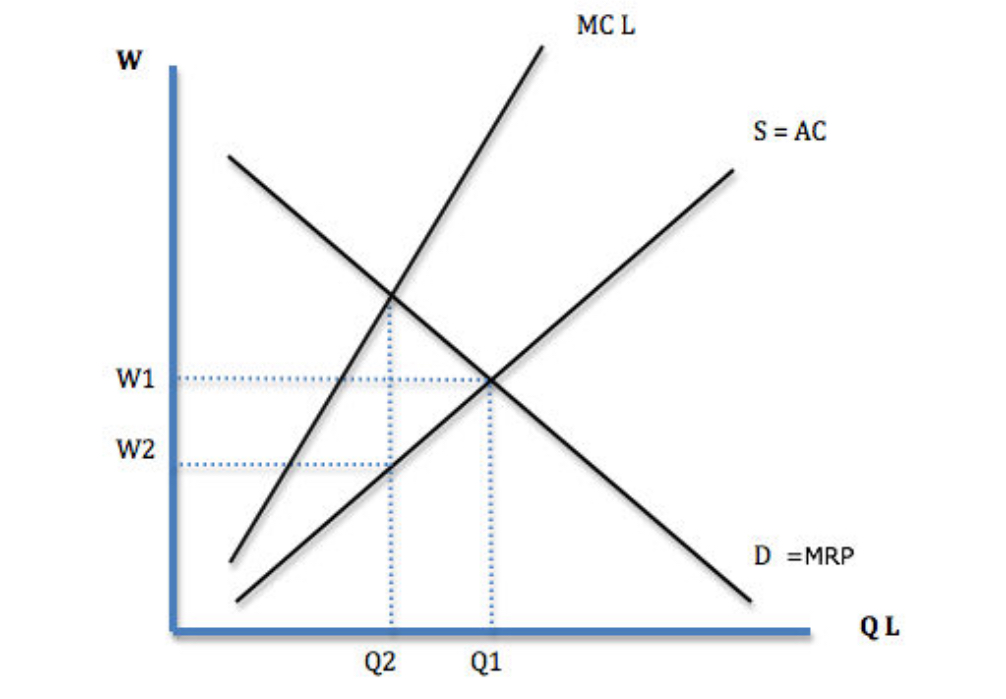
Draw diagram showing how monopsony exploitation represents market failure.
There is transfer of income from workers to owners (grey area) (increasing income inequality)
There is also DWL (yellow triangle). This shows loss of earnings that are not captured by the employer.
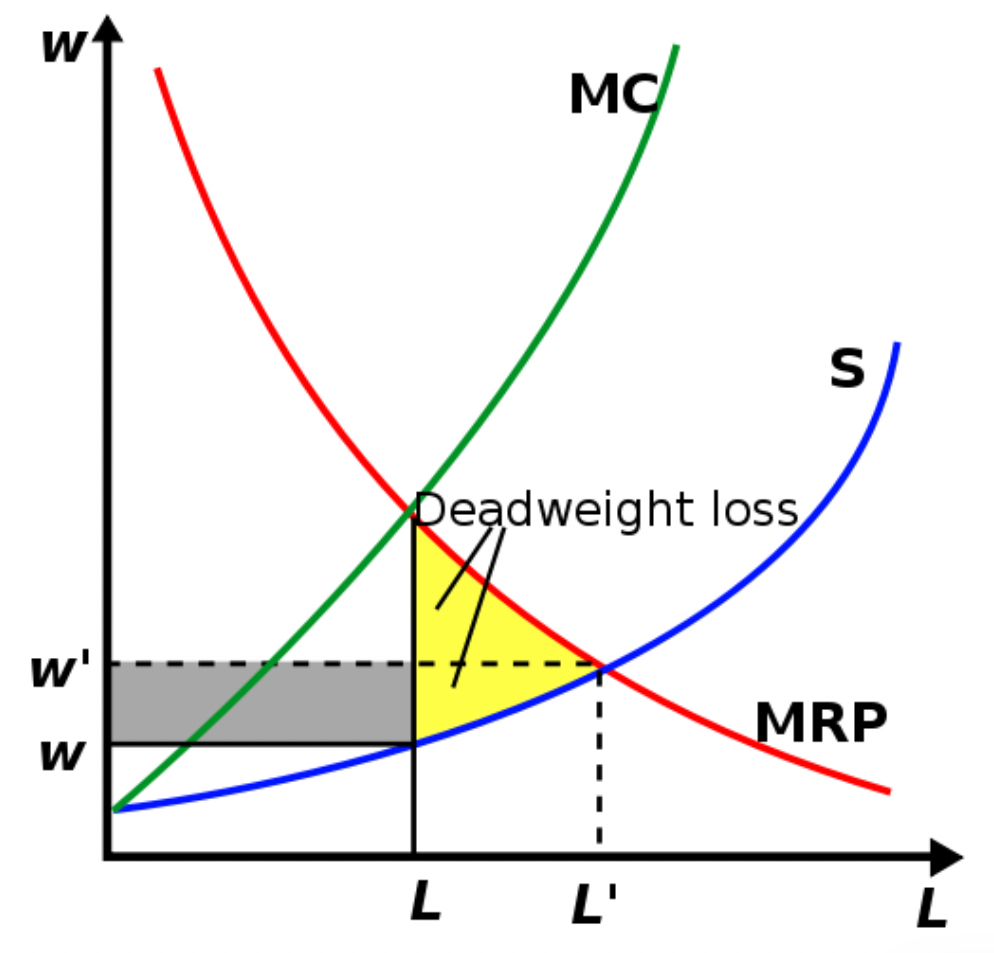
Is there monopsony in modern economy?
It makes sense that mill owner in Victorian Britain had monopsony power. However, do firms have monopsony power today? Is much greater diversity in economy. Workers rarely faced with a single employer in a town.
Arguably, despite theoretical choice of employers, in practice, many workers find it difficult to ‘choose employers’ or move jobs.
How is govt. employer a source of monopsony power?
Many modern pure monopsonies are govt. jobs.
E.g. police have only 1 potential employer – the govt.
To lesser extent, nurses and teachers face little choice apart from govt.
However, govt. doesn’t set wages like a profit max. firm, but due to other factors.
How is u/e a source of monopsony power?
When u/e is high, arguably firms gain more monopsony power.
Someone who has unsuccessfully applied for many jobs is more willing to accept lower wages to get a job.
How is lack of info. a source of monopsony power?
theory of comp. lab. mkts assumes workers have access to diff. job wage rates and potential sources of employment.
but, in practice, it is difficult to have all the relevant info.
How is geographical immobility a source of monopsony power?
Often work is chosen on grounds of geographical proximity or other non-wage factors (rather than wage rates).
Therefore, even if higher paid work may be available elsewhere, it is not worth the extra commute.
How is shift patterns a source of monopsony power?
Many workers (especially part-time / parents with families) may have limited hours they can work.
A firm which allows flexible working hours to pick up children may be the only realistic choice for a worker.
Therefore, this gives the employer monopsony power.
How is difficulties in moving jobs a source of monopsony power?
Workers have a great reluctance to leave work.
You can’t just change jobs like deciding to buy a different type of cereal.
A worker will lose on the job training, and firms are reluctant to employ workers who have a habit of moving frequently to get slightly higher pay.
How is monopoly power in selling products a source of monopsony power?
A firm with monopoly selling power is more likely to have a degree of monopsony power.
Why do many firms have monopsony / oligopsony power?
Therefore, for many part-time / low skilled workers, they face relatively few job opportunities with very limited ability to bargain for higher wages.
Therefore, many modern companies have degree of monopsony power / oligopsony power in employing workers.
This has implications for min, wages/living wages
What has growth in part-time service sector jobs done?
Arguably, the growth in part-time service sector jobs has increased firms monopsony power and is one reason behind the growth in UK income inequality.
What are problems of monopsony exploitation in labour markets?
Lower wages
Increased wage inequality
Workers lack bargaining power in getting improved working conditions.
Reduced labour productivity due to lack of motivation and feeling of being valued.
How can efficiency wage theory be seen with monopsony?
Arguably firms may choose not to exercise their monopsony power in setting profit maximising wage.
Setting higher wages and improving labour market conditions might increase labour market productivity and loyalty.
How can monopsony exploitation be seen in product markets?
Firms can have monopsony power in buying raw materials/goods.
E.g. it is argued that supermarkets abuse their monopsony power to pay low prices to farmers for goods like milk and butter. If farmers don’t sell to supermarkets at low price, they have no alternative buyer willing to purchase large quantities.
What are multiple variables that contribute to market inefficiencies?
Multiple variables that contribute to market inefficiencies are characteristics of imperfectly competitive labour markets.
What must govt. , employees and employers understand?
To solve market inefficiencies and work towards fair and effective wage outcomes, governments, employees, and employers must have a thorough understanding of these issues.
What can stakeholders endeavour to do?
Stakeholders can endeavour to create a more balanced and equitable employment market environment by recognising the difficulties created by imperfectly competitive labour markets.
What setters are monopsony employers?
Monopsony employers are wage setters as the amount of workers they employee is high relative to the supply of labour - they have great wage setting power - so, in essence, just like a monopoly they are price makers
What are monopsony employers assumed to be?
Monopsony employers are assumed to be profit maximisers - this means they’ll set the wage at the point where MRP = MC
What will total employment be?
Total employment in the market will be lower - this is because the monopsony employer drives down wages to a level lower than would be under perfect competition - lower wages disincentivise some workers from supplying their labour
What will monopoly firms also be?
Monopoly firms will alot of the time also be monopsony firms - e.g., if you wish to purchase a computer, your options will be either Microsoft, Apple or Google when it comes to the operating system.
On the other side of the coin, Microsoft, Apple and Google are probably some of the largest employers of software developers
How can trade unions be a good thing?
A strong TU in presence of monopsonistic mkt can be a good thing for labour markets that underpay workers
good example of this is sig size of TUs that operate within realm of state-run services such as the healthcare, schools, public transport etc
in such cases, TU can restore balance of mkt power & successfuly campaign for better pay, fewer working hours & better working conditions within their job roles
What is a monopsony employer in the context of labour markets?
A single buyer or employer that dominates the labour market is referred to as a monopsony employer.
The employer now has considerable market power to set wage rates and employment levels.
This is in contrast to a perfectly competitive labour market where there would be multiple small firms hiring workers.
How does a monopsony employer use its market power to influence wage rates and employment levels?
monopsony employer can lower employment levels and relative wage rates below those that would be present in a labour market with perfect competition. can impose downward pressure on salaries & restrict job possibilities for workers by hiring fewer people and paying less than the competitive wage.
their profit max. nature coupled with lack of competitor employers means monopsony employer is able to earn sup. profits by underpaying workers. monopsony’s chosen level of workers hired corresponds with profit max. wage rate - this is achieved at the point MRP = MC.
What role do trade unions play in imperfectly competitive labour markets?
Workers' collective negotiating power in lab. mkt is represented by TUs.
TUs bargain with employers on behalf of employees to obtain better pay, benefits, and working conditions.
Strong TUs operating within monopsonistic mkt can work to balance mkt power of monopsonistic firms & pursue more favourable wage outcomes.
However, when TU operates in more comp. mkt, outcome may be negative & create additional u/e.
Why in order to employ one extra worker does the firm has to increase the wages of all workers?
Just think of an upwardly sloping supply curve of labour.
If the firm offers wage of £100, can employ 10 workers.
To employ 11 workers, would have to increase wage rate to £110.
Therefore, according to this supply curve, if firm needs to employ 11 workers firm has to pay every worker £110. Therefore MC of employing an 11th worker is £210 (11*110 = £1,210 – 10*100). MC of 11th worker is greater than AC
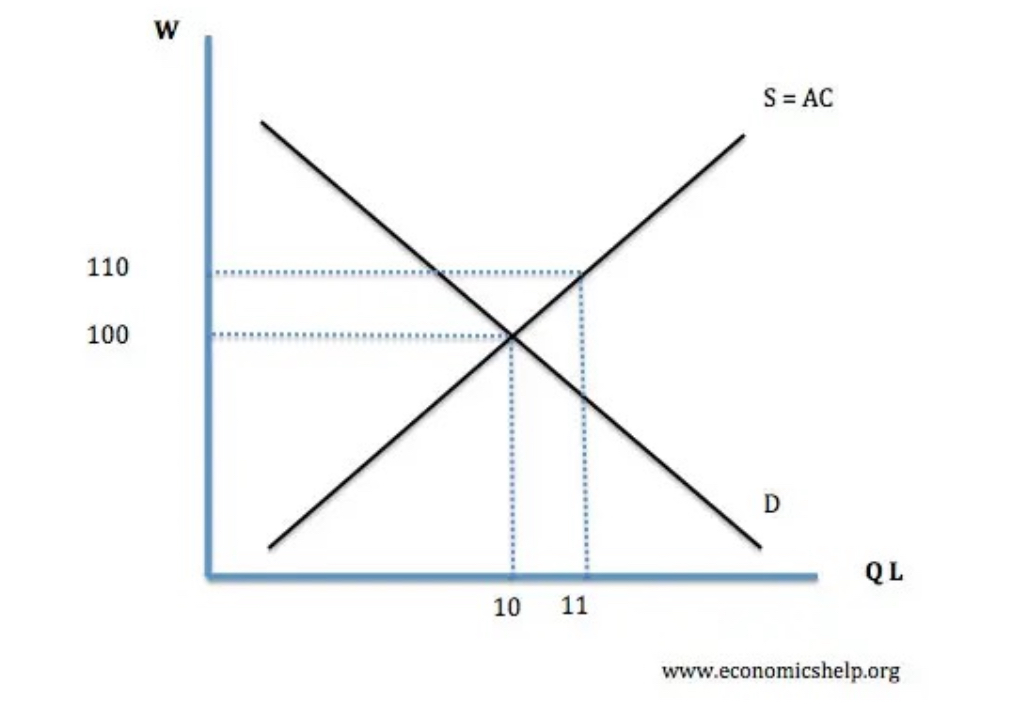
How does wage discrimination present exception to this theory?
1 exception would be if monopsonist could wage discriminate – i.e. pay £110 to extra worker, but continue to pay £100 to existing mine workers. In reality this could be possible.
E.g. firm could intro. special post or job title which pays £110, whilst existing workers get stuck on £100. If monopsony can get away with this, won’t have to pay every worker £110.
How can elastic supply present exception to this theory?
Another poss. is the S curve is v. elastic, therefore there may be infinite (or at least a v. large) S of labour at £100.
E.g. in period of high u/e, there are probably many workers willing to supply there labour at £100. Many coal mine owners may find, even at low wages, a large pool of unemployed workers willing to take a job at £100.
However, theory of upward sloping supply curve suggests MC of employing extra worker will increase faster than AC.
Why is monopsonist reluctant to hire extra workers?
Key thing is that monopsonist is reluctant to hire extra workers, precisely because it would have to increase wages of all workers (high MC).
Because of this prospect the monopsonist prefers to employ less workers & pay lower wages.
To profit max, it avoids extra MC of paying all workers more.